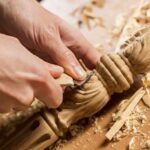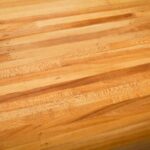Spruce wood is a popular choice for woodworking projects due to its strength, durability, and flexibility. This type of wood has been used in woodworking for centuries and has a rich history in the craft. In this article, we will explore the properties of spruce wood, its uses in woodworking, different types available, and tips for working with it effectively. Additionally, we will compare spruce wood to other types of wood and discuss its sustainability and environmental impact.
When it comes to woodworking, understanding the characteristics of different types of wood is essential. Spruce wood, known for its light color and fine grain, is highly valued for its versatility in a wide range of woodworking projects. From furniture making to cabinetry and even musical instrument construction, spruce wood has proven to be an excellent choice for both amateur and professional woodworkers.
In the following sections, we will delve into the specific properties of spruce wood, its common uses in woodworking, as well as tips for working with this material effectively. Whether you are new to woodworking or looking to expand your knowledge of different types of wood, this article will provide valuable insights into the suitability of spruce wood for various woodworking projects.
Properties of Spruce Wood
Spruce wood is a popular choice for woodworking due to its notable properties that make it suitable for a wide range of projects. This type of wood is known for its strength, durability, and flexibility, which are essential characteristics for creating long-lasting and resilient wooden items. Additionally, spruce wood is versatile in woodworking projects, allowing for various applications and designs. However, like any material, spruce wood also has its advantages and disadvantages when used in woodworking.
Strength, Durability, and Flexibility
One of the reasons why spruce wood is good for woodworking is its impressive strength and durability. It has a high strength-to-weight ratio, making it suitable for load-bearing structures like furniture and cabinetry. The flexibility of spruce wood also makes it ideal for intricate designs and complex joinery work. Woodworkers can rely on the stability and resilience of spruce wood when crafting their projects.
Versatility in Woodworking Projects
Spruce wood’s versatility allows it to be used in a wide range of woodworking projects. From simple DIY crafts to complex furniture making, this type of wood can adapt to various design requirements. Its relatively straight grain pattern makes it easy to work with when cutting, shaping, or carving intricate details.
Advantages and Disadvantages
While spruce wood offers many benefits for woodworking, it also comes with some disadvantages. On the positive side, spruce is relatively affordable compared to other hardwoods but still offers great workability. However, due to its softer nature compared to hardwoods like oak or maple, it may be more prone to dents and scratches over time. Knowing these advantages and disadvantages can help woodworkers make informed decisions when choosing materials for their projects.
Uses of Spruce Wood in Woodworking
Spruce wood is a popular choice in woodworking due to its versatility and desirable properties. The lightweight nature of spruce wood makes it easy to work with, making it an ideal material for various woodworking projects. Here are some common uses of spruce wood in the woodworking industry:
- Furniture Making: Spruce wood is commonly used in creating furniture pieces such as tables, chairs, and bed frames. Its strength and durability make it suitable for everyday use in households.
- Cabinetry and Joinery: Spruce wood is often used in cabinetry and joinery due to its stability and ease of working. It can be easily shaped and finished to achieve a polished look in cabinets, shelves, and other storage solutions.
- Musical Instrument Construction: One unique use of spruce wood is in the construction of musical instruments, particularly acoustic guitars and violins. The resonant properties of spruce contribute to the quality of sound produced by these instruments.
It is important to note that while spruce wood is widely used in woodworking, there are some disadvantages to consider. For instance, its softness can make it prone to dents and scratches if not properly treated or finished. Additionally, the light color of spruce wood may not be suitable for certain aesthetic preferences or design styles.
Types of Spruce Wood
Spruce wood comes in various types, each with its own unique characteristics and suitability for different woodworking projects. Understanding the different types of spruce wood is important for woodworkers to make informed choices when selecting materials for their projects.
Classification Based on Color and Texture
Spruce wood can be classified into several types based on its color and texture. For example, there is Sitka spruce, which is known for its light color and fine grain. This type of spruce wood is often favored for making musical instruments due to its acoustic properties. On the other hand, Norway spruce has a slightly darker color and coarser texture, making it suitable for construction purposes such as framing and general carpentry.
Different Grades and Cuts for Specific Woodworking Projects
In addition to variations in color and texture, spruce wood also comes in different grades and cuts that cater to specific woodworking needs. Clear-grade spruce lumber, for instance, has minimal knots and is often used in high-quality furniture making. Conversely, knotty spruce lumber with more imperfections may be preferred for rustic or outdoor projects where aesthetics is less of a concern.
Understanding the different types, grades, and cuts of spruce wood is crucial in ensuring that the right material is selected for a particular woodworking project. The versatility of spruce wood makes it a popular choice among woodworkers, but knowing which type to use can significantly impact the overall quality and appearance of the finished product.
Considerations When Using Specific Types of Spruce Wood
When working with different types of spruce wood, woodworkers should take into account their individual characteristics. For example, Sitka spruce‘s excellent strength-to-weight ratio makes it perfect for crafting aircraft structures or boat building while providing a high level of workability. Conversely, Norwegian spruces’ coarser texture might require extra care when sanding or finishing to achieve a smooth surface.
Ultimately, understanding the nuances between different types of spruce wood allows woodworkers to make educated decisions about which type best suits their specific woodworking project’s requirements – whether it be structural support or visual appeal.
Tips for Working With Spruce Wood
When it comes to working with spruce wood, there are some important tips to keep in mind in order to achieve the best results. Here are some key guidelines for woodworking with spruce wood:
- Preparing and treating spruce wood: Before starting any woodworking project with spruce wood, it is essential to properly prepare and treat the wood. This includes ensuring that the wood is properly dried to avoid warping, and sealing the surface to prevent moisture absorption.
- Techniques for shaping, cutting, and joining spruce wood: Due to its softness and straight grain, spruce wood is relatively easy to shape, cut, and join. However, it is important to use sharp tools and proper techniques to avoid splintering or tear-out.
- Best practices for finishing and preserving spruce wood: When it comes to finishing spruce wood, it is important to choose the right type of finish for the specific project. Additionally, applying a protective coating will help preserve the natural beauty of the wood while also enhancing its durability.
Working with spruce wood requires attention to detail and proper handling in order to achieve the desired outcome. By following these tips, woodworkers can make the most of this versatile material.
Overall, when considering whether spruce wood is good for woodworking projects keyword we find that it may be a suitable option due to its workability and versatility. However,it is important factor in proper preparation and handling of this type of wood in order to achieve optimal results.
Comparing Spruce Wood to Other Woods
When it comes to woodworking, the choice of wood material plays a crucial role in the success of any project. One common question that arises is, “Is spruce wood good for woodworking?” To answer this, it is essential to compare spruce wood with other types of woods commonly used in woodworking, such as pine, cedar, and fir.
Compared to pine, spruce wood has a higher strength-to-weight ratio, making it a more durable option for load-bearing structures. It also has a finer texture and grain pattern than pine, making it ideal for projects that require a smoother finish. Additionally, spruce wood is known for its flexibility, allowing for easier shaping and carving compared to pine.
In comparison to cedar, spruce wood offers similar properties in terms of durability and workability. However, cedar is known for its natural resistance to decay and insect infestation, making it a preferred choice for outdoor applications such as decking and fencing. On the other hand, spruce wood’s affordability and availability make it a popular choice for indoor furniture and cabinetry.
Fir is another type of wood often used in woodworking projects. While both fir and spruce wood are known for their strength and versatility in various applications, fir tends to be heavier and harder than spruce. This makes spruce wood more suitable for projects that require lighter weight without sacrificing structural integrity. Ultimately, the choice between fir and spruce wood depends on the specific requirements of the woodworking project at hand.
Sustainability and Environmental Impact
The sustainability and environmental impact of using spruce wood is an important consideration in the woodworking industry. Spruce wood is considered to be a sustainable option for woodworking due to its fast growth rate and abundance. This type of wood is widely available in North America and Europe, making it a popular choice for many woodworking projects. Additionally, spruce trees are often planted specifically for harvesting, which helps to maintain a steady supply of this material without depleting natural forests.
In terms of environmental impact, using spruce wood for woodworking can have both positive and negative effects. On the positive side, this type of wood is biodegradable and renewable, making it an eco-friendly choice for furniture, cabinetry, and other woodworking applications. However, there are also concerns regarding deforestation practices and the potential impact on wildlife habitats when harvesting spruce wood. It is important for woodworkers to source their spruce wood from reputable suppliers who adhere to sustainable forestry practices.
| Sustainability Factor | Impact |
|---|---|
| Renewability | Spruce wood is renewable due to fast growth rate |
| Deforestation Concerns | Potential impact on natural forests if not sustainably managed |
| Biodegradability | Spruce wood is biodegradable, making it an eco-friendly option |
| Sourcing and Certification | Importance of sourcing from certified sustainable suppliers |
It is also worth noting that there are certification programs such as the Forest Stewardship Council (FSC) and Sustainable Forestry Initiative (SFI) that provide guidelines for responsible forestry management. Woodworkers can look for these certifications when purchasing spruce wood to ensure that they are supporting sustainable practices.
Conclusion
In conclusion, spruce wood is a versatile and widely used material in woodworking due to its strength, durability, and flexibility. Its light color and smooth texture make it an ideal choice for a variety of projects, including furniture making, cabinetry, joinery, and even musical instrument construction. While spruce wood has its advantages, such as being easy to work with and readily available, it also has some drawbacks, such as its susceptibility to dents and scratches.
When comparing spruce wood to other woods like pine, cedar, and fir, it becomes evident that spruce wood is a favorable option for many woodworking projects. Its sustainability is also an important factor to consider, as responsible sourcing and harvesting practices ensure the longevity of this valuable resource. It is essential for woodworkers to be mindful of the environmental impact and choose certified sustainable spruce wood for their projects.
Overall, while there are both pros and cons to using spruce wood in woodworking, it remains a popular choice for many craftsmen. Whether it’s for its structural integrity or aesthetic appeal, there is no denying that spruce wood has made its mark in the world of woodworking. Aspiring woodworkers should feel encouraged to explore the possibilities that spruce wood offers and unleash their creativity in their own woodworking endeavors.
Frequently Asked Questions
What Are the Negatives of Spruce Wood?
The negatives of spruce wood mainly revolve around its softness and lack of durability compared to other hardwoods. It is more susceptible to dents, scratches, and decay, making it less ideal for high-traffic areas or outdoor use.
What Is the Best Use of Spruce Wood?
The best use of spruce wood is in construction and woodworking projects that don’t require high durability. It is commonly used for framing, roof trusses, and interior trim due to its lightweight nature and ease of working with tools.
Can Spruce Wood Be Used for Furniture?
Spruce wood can be used for furniture, but it may not be the best choice for pieces that will face heavy wear and tear. However, the light color and smooth texture of spruce make it suitable for crafting simple, affordable furniture pieces when properly finished and maintained.

Hi everyone! I’m a woodworker and blogger, and this is my woodworking blog. In my blog, I share tips and tricks for woodworkers of all skill levels, as well as project ideas that you can try yourself.





